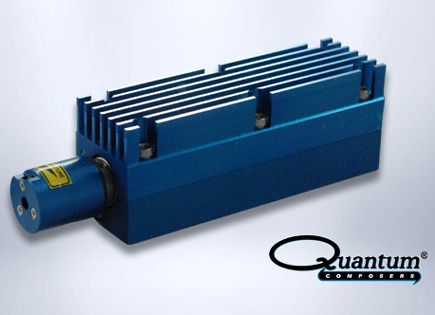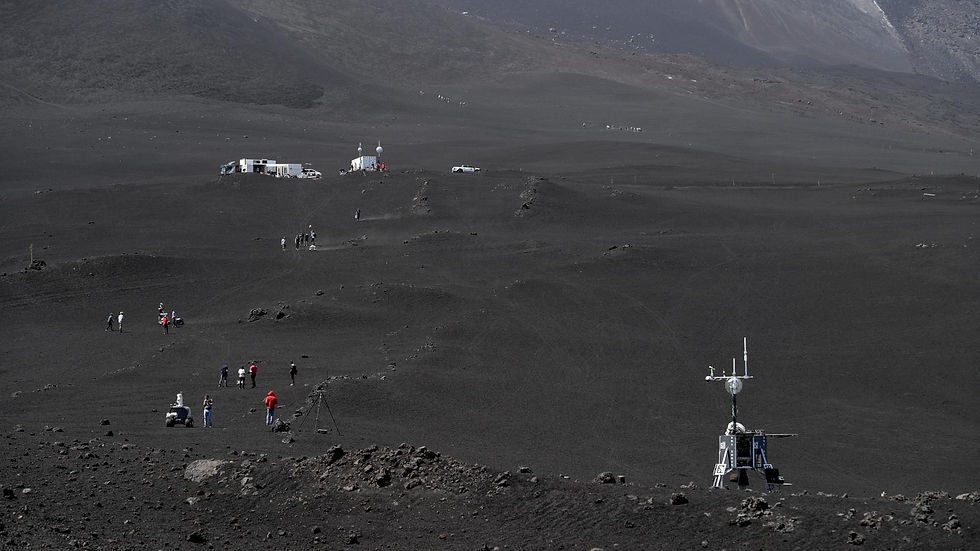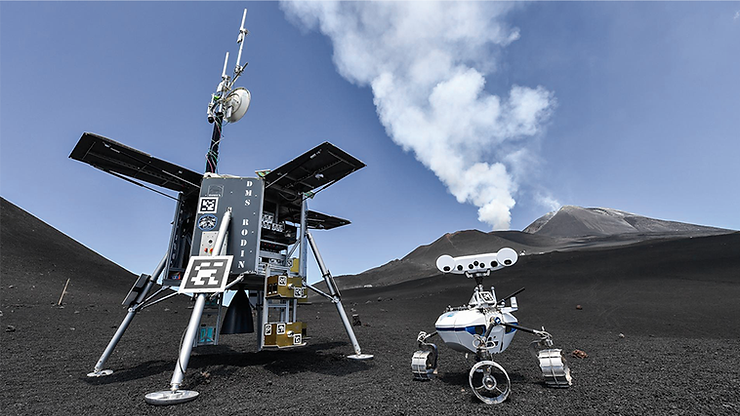Share this
Successful LIBS Research Through Autonomous Robotic Exploration with Dr. Susanne Schroeder
December 5, 2022
Lightweight, high-performing laser system helps experiment go from lab to Mt. Etna
Dr. Susanne Schroeder, a leading researcher in LIBS and Raman spectroscopy with the German Aerospace Center (DLR) Institute of Optical Sensor Systems, shares the results of her latest LIBS experiment, utilizing the Quantum Composers’ MicroJewel Nd:YAG DPSS laser, and the implications of her work on the ARCHES program for autonomous robotic exploration and inspection.
First, congratulations on the success of your latest field experiment. Tell us about it!
My colleagues and I have developed a Laser-Induced Breakdown Spectroscopy (LIBS) instrument for ARCHES (Autonomous Robotic Networks to Help Modern Societies), a multi-agency, multi-robot project led by DLR. We recently conducted live robotic tests on Mount Etna, which we chose due to its similarities to the lunar surface. The tests went well, and we were able to demonstrate the functionality of our LIBS instrument handled by a DLR rover.
LIBS is well suited for robotic exploration and the analysis of rocks and soils. We began to design the LIBS instrument for this program in 2018 and have conducted many successful lab experiments, and we are pleased to see its success in field testing.
How was the LIBS instrument deployed on the rovers?
The LIBS instrument is designed to fit in a modular payload box and is built from commercial components, including Quantum Composers’ custom Nd:YAG laser, a commercial spectrometer, and a movable mirror to gather data along a short arc. It rides on the rover like a backpack until the rover reaches the target area, then is picked up by the rover’s robotic arm and placed in contact with the sample. A distancing baffle ensures that the sample is in the focal plane of the laser. After the measurement is done, the robot places the payload box on its back and travels to the next target.

What requirements posed challenges?
Payload was the most critical consideration. We chose the MicroJewel because it was the lightest weight and highest performing laser available. While space-ready requirements present a number of challenges, it was important for us to select commercially available components for these experiments. The MicroJewel was easy to integrate with the sensor head and is so compact that we will be able to further reduce the footprint of the LIBS instrument overall.
Also, designing the instrument for use in the atmosphere is different from designing for LIBS in low pressure or vacuum. LIBS creates a plasma from the sample material, and the plasma decays very quickly in little or no atmosphere. On Earth, the atmosphere confines the plasma and expands its lifetime.
The shock of launch and very low temperatures during space travel are also important considerations when designing hardware for LIBS in space as well as low mass and power consumption requirements.
Why was LIBS spectroscopy the right choice for material analysis?
LIBS works exceptionally well on Mars due to the thin atmosphere and just requires optical access. NASA’s Martian rovers carry rather big LIBS instruments on their masts, and the optics can focus the lasers at distances of up to several meters. For ARCHES, which simulates a lunar mission, we moved to a configuration where a robotic arm brings a much smaller instrument in contact with the sample. And it has proven to be very effective to put the LIBS instrument on the rock and start the analysis.
In-situ analysis on Mars or bodies without an atmosphere such as the Moon is very different from doing research in ambient conditions on Earth. For space instrumentation, we face completely different design challenges. However, the configuration of our ARCHES LIBS module for the demo mission of autonomous robots was ideal for this scenario—we are happy with the capabilities of our LIBS instrument and with the data from Mt. Etna.
Where are the most promising applications for LIBS via autonomous robots?
This demonstration proved that DLR’s LRU2 rover and our LIBS module work nicely together and that we can gather geologically interesting data in the field. Robots equipped with LIBS instruments can be used on Earth for scouting for specific elements or analyzing hazardous environments where humans should not go. The demo mission was one important step on our way to developing LIBS instruments for planetary exploration but also showed the value for terrestrial applications.
ARCHES is unique in its approach to deploying multiple complementary robots, which increases the scientific return and scope of robotic missions. Currently, we are developing a second mobile LIBS unit with the MicroJewel laser for upcoming projects, one of which with the goal to analyze sands and soils in an Earth-focused sustainability context.
There is a lot of interest right now in going to the Moon. An important aspect of upcoming missions will be to detect resources like water ice that can help to support sustained human presence on the Moon. Water ice could also be used for fuel to travel further. Detecting these resources is a very different but promising application for a LIBS space instrument. Surveying extraction processes could be another application.
What surprised you in the move from lab testing to the field?
There are so many interdependencies in a multi-robot mission with a multidisciplinary team that I was a bit surprised it ran as smoothly as it did, especially since we usually work inside a warm laboratory! It is nice to work with such a talented team.

The demonstration mission on Mount Etna was originally planned for 2020 but was postponed due to the pandemic. We already have years of lab run time, but I am very pleased to see it perform as planned in the field.
Read the full case study on the ARCHES project and contact our experts to design your laser.
Share this
- photonics (19)
- Lasers (12)
- DPSS Lasers (10)
- pulse delay generator (8)
- pulse generator (8)
- LIDAR (4)
- Lasers and Optics (4)
- Technology (4)
- Laboratory Science (3)
- Nd:YAG Lasers (3)
- PIV (3)
- Science (3)
- Spectroscopy (3)
- custom laser systems (3)
- Aerospace studies (2)
- Commercial Lasers (2)
- LIBS (2)
- Laser Induced Breakdown Spectroscopy (2)
- Laser Research (2)
- Laser Science (2)
- Particle Image Velocimetry (2)
- Pulsed Lasers (2)
- custom lasers (2)
- laser ablation (2)
- laser system (2)
- Biotech (1)
- COVID (1)
- Cancer (1)
- Cancer Diagnostics (1)
- Cancer Research (1)
- Current Generators (1)
- Dentistry (1)
- Emerald Pulse Generator (1)
- Flame Kernel (1)
- High Current Pulse Generator (1)
- Ignition and Combustion (1)
- Ignition flame kernel (1)
- Laser Dentistry (1)
- Laser Manufacturing (1)
- Laser Soldering (1)
- Laser Tooth (1)
- Laser aerospace (1)
- Laser photonics (1)
- MDA (1)
- Mass Spectroscopy (1)
- Micro Soldering (1)
- PIV Laser (1)
- Physics (1)
- Research (1)
- Surface mounted technology (1)
- ablation (1)
- artemis nasa (1)
- blue lasers (1)
- delay generator (1)
- er marketing (1)
- laser attenuator (1)
- laser modules (1)
- laser quality (1)
- laser sales and marketing (1)
- laser synchronizer (1)
- lasers for botanical safety (1)
- lasers for cannabis (1)
- lasers purity (1)
- lasers space (1)
- lunar mission 2021 (1)
- lunar missions (1)
- nasa lasers (1)
- nasa payload (1)
- oem lasers (1)
- photonics sales and marketing (1)
- system synchronizer (1)
- February 2024 (1)
- October 2023 (1)
- December 2022 (1)
- November 2022 (2)
- July 2022 (1)
- May 2022 (1)
- March 2022 (1)
- January 2022 (1)
- December 2021 (2)
- November 2021 (2)
- September 2021 (1)
- August 2021 (1)
- July 2021 (2)
- June 2021 (1)
- May 2021 (2)
- April 2021 (1)
- March 2021 (3)
- February 2021 (1)
- January 2021 (2)
- December 2020 (1)
- November 2020 (2)
- October 2020 (2)
- September 2020 (4)
- August 2020 (3)
- July 2020 (3)
- June 2020 (4)
- May 2020 (2)
- April 2020 (6)
- March 2020 (3)
- February 2020 (3)
- December 2019 (2)
- November 2019 (3)
- October 2019 (2)
- September 2019 (1)
- August 2019 (2)
- May 2019 (1)
- April 2019 (1)
- February 2019 (1)
- October 2018 (2)
- September 2018 (2)
- August 2018 (2)
- July 2018 (1)
- June 2018 (1)
- April 2018 (1)
- March 2018 (1)
- February 2018 (1)
- January 2018 (1)
- December 2017 (2)
- September 2017 (3)
- July 2017 (2)
- June 2017 (2)
- March 2017 (4)
- January 2017 (2)
- November 2016 (2)
- September 2016 (2)
- August 2016 (1)
- May 2016 (1)
- April 2016 (1)
- March 2016 (2)
- December 2015 (2)
- October 2015 (2)
- September 2015 (1)

